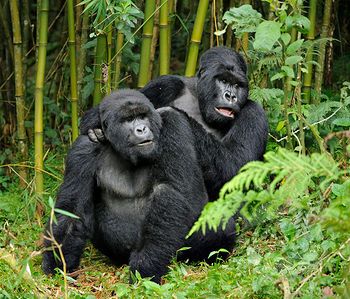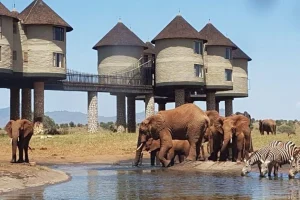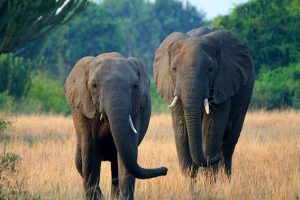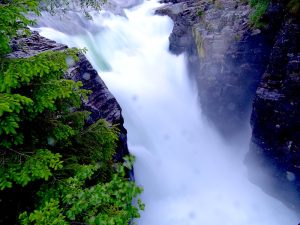What are the main threats to mountain gorilla populations?
Mountain gorillas face multiple threats that put their survival at risk despite ongoing conservation efforts. Key threats include habitat loss, poaching, human-wildlife conflict, disease transmission, and climate change. These factors combine to create a fragile environment for gorillas, who already have a small and geographically restricted population. With fewer than 1,100 individuals left in the wild, mainly in Uganda, Rwanda, and the Democratic Republic of Congo, the species remains highly vulnerable to both natural and human-induced pressures. Threats to the Mountain Gorilla Population
How does habitat loss affect mountain gorillas?
Habitat loss is one of the most significant threats to mountain gorillas. Expanding human settlements, agricultural activities, and infrastructure projects continue to reduce and fragment gorilla habitats in the Virunga Massif and Bwindi Impenetrable National Park. As forests shrink, gorillas face limited access to food sources, restricted movement, and increased contact with humans. This leads to reduced genetic diversity and makes gorillas more susceptible to disease and conflict. Long-term habitat degradation directly undermines the survival of mountain gorilla populations.
Why is poaching a threat to mountain gorillas?
Poaching remains a persistent threat to mountain gorillas, even though they are not the primary target. Gorillas are often caught in snares set for other animals such as antelope or bush pigs. These traps can cause severe injuries or death. In some cases, gorillas are deliberately targeted for bushmeat or captured for illegal wildlife trade. Poaching not only reduces gorilla numbers but also disrupts group dynamics and social structures, as the death of a dominant silverback can destabilize an entire family unit. Threats to the Mountain Gorilla Population
How do human-wildlife conflicts impact mountain gorillas?
Human-wildlife conflict arises when gorillas move outside protected areas into farmlands. As gorillas forage for food, they sometimes raid crops, leading to tensions with local communities. Farmers may retaliate by setting traps or using aggressive measures to drive gorillas away, which can result in injuries or fatalities. This conflict undermines conservation efforts and highlights the delicate balance between protecting endangered species and supporting human livelihoods near gorilla habitats. Threats to the Mountain Gorilla Population
What diseases threaten mountain gorillas?
Diseases are a growing concern for mountain gorillas due to their genetic similarity to humans. Respiratory infections, including pneumonia, are among the most common threats transmitted from humans to gorillas. Increased human presence through tourism, research, and local community interaction heightens the risk of disease outbreaks. In addition, gorillas are vulnerable to parasites and other illnesses, which can spread rapidly through tightly bonded family groups. With limited genetic diversity, their ability to recover from disease outbreaks is reduced.
How does climate change affect mountain gorillas?
Climate change threatens mountain gorillas by altering their habitats and food availability. Shifts in rainfall patterns and rising temperatures affect vegetation growth, reducing the availability of plants that gorillas rely on for survival. Extreme weather events, such as heavy rains and droughts, also impact gorilla habitats, making them less stable. As ecosystems shift, gorillas may be forced into smaller areas, increasing competition for resources and intensifying human-wildlife conflicts. Climate change adds another layer of uncertainty to the species’ future survival.
Why is deforestation dangerous for mountain gorillas?
Deforestation caused by logging, charcoal production, and agricultural expansion is a direct threat to mountain gorilla populations. Clearing forests removes the vegetation gorillas depend on and fragments their habitats into smaller, isolated patches. This fragmentation reduces genetic exchange between groups and increases the likelihood of inbreeding. In addition, deforestation brings gorillas closer to human settlements, heightening risks of disease and conflict. Protecting intact forests is crucial to maintaining viable mountain gorilla populations.
How does agricultural expansion threaten mountain gorilla habitats?
Agricultural expansion continues to encroach on mountain gorilla habitats as human populations grow. In regions surrounding Bwindi Impenetrable Forest and the Virunga Mountains, farmland is carved out of forested areas to meet the demand for food and income. This expansion reduces available land for gorillas and increases human-gorilla encounters. In some cases, gorillas are forced to feed on crops, escalating conflicts. Agricultural development also introduces chemicals, pesticides, and habitat disturbances that negatively impact biodiversity. Threats to the Mountain Gorilla Population
What role does political instability play in threatening mountain gorillas?
Political instability, especially in the Democratic Republic of Congo, poses serious risks to mountain gorillas. Armed conflicts often take place in or near national parks, disrupting conservation efforts and endangering both gorillas and rangers. In times of instability, poaching and illegal resource extraction increase as enforcement weakens. Conservation areas may be abandoned or underfunded, leaving gorillas vulnerable to exploitation. Political instability therefore not only threatens human security but also undermines the long-term survival of mountain gorillas.
How does tourism impact mountain gorillas?
Tourism provides vital funding for mountain gorilla conservation but also poses potential risks. High levels of tourist interaction increase the chance of disease transmission from humans to gorillas. Stress caused by frequent human presence can alter gorilla behavior, including reduced feeding or disrupted rest. Poorly managed tourism can damage habitats through trampling and littering. Strict regulations, including limited group sizes and minimum viewing distances, are in place to minimize these risks, but enforcement is essential to ensure tourism remains sustainable.
Are snares and traps a danger to mountain gorillas?
Yes, snares and traps set for other animals pose a serious danger to mountain gorillas. Gorillas often become entangled in wire snares, which can cause deep wounds, infections, or permanent disabilities. Juvenile gorillas are especially vulnerable as they are more curious and less cautious. Anti-poaching patrols regularly search for and remove snares, but the sheer number of traps laid in forest areas continues to present an ongoing challenge for conservationists.
How does human encroachment affect mountain gorilla survival?
Human encroachment reduces the size of protected areas and increases the overlap between human and gorilla territories. As human populations expand, forests are converted into farmland, settlements, or roads. Encroachment not only diminishes gorilla habitats but also increases direct interactions, raising risks of disease, conflict, and habitat degradation. Encroachment also disrupts conservation strategies by creating fragmented landscapes that are harder to protect and manage effectively.
Why is inbreeding a concern for mountain gorilla populations?
Mountain gorillas have a small population size, making them vulnerable to inbreeding. When closely related individuals breed, genetic diversity declines, leading to increased risks of birth defects, reduced fertility, and susceptibility to disease. Fragmented habitats caused by human activity limit opportunities for gene flow between different gorilla groups, compounding the risk of inbreeding. Conservation strategies, such as protecting wildlife corridors, are critical for maintaining genetic diversity among mountain gorilla populations.
What are the effects of illegal logging on mountain gorillas?
Illegal logging contributes to habitat destruction and directly impacts mountain gorillas by reducing the availability of food plants and shelter. Logging activities open up forest areas, allowing further human encroachment and illegal activities. Roads built for logging also fragment habitats and provide access for poachers. Although conservation authorities monitor protected areas, illegal logging persists in some regions due to high demand for timber and fuelwood.
How does livestock grazing threaten mountain gorilla habitats?
Livestock grazing inside or near protected areas degrades habitats and reduces food availability for mountain gorillas. Domestic animals compete with gorillas for vegetation, trample delicate ecosystems, and spread diseases that can infect wildlife. In areas where pastoral communities graze cattle in or near gorilla habitats, conflicts often arise, as grazing undermines conservation efforts and creates tensions between communities and park authorities.
How do infrastructure developments affect mountain gorilla populations?
Infrastructure projects such as roads, mining, and settlements can severely affect gorilla populations by fragmenting habitats and increasing human access to previously remote areas. Roads make it easier for poachers to enter protected zones, while mining disrupts ecosystems and introduces pollutants. Infrastructure also leads to noise pollution and habitat fragmentation, both of which negatively impact gorilla behavior and survival. Careful planning and environmental impact assessments are essential to balance development with conservation.
Why are mountain gorillas considered critically endangered?
Mountain gorillas are considered critically endangered due to their limited population size, restricted habitats, and ongoing threats from human activity and environmental pressures. Although conservation efforts have improved their numbers in recent years, they remain highly vulnerable to disease outbreaks, poaching, and habitat destruction. The species’ dependence on a small range of protected areas makes them especially susceptible to localized threats. Their critically endangered status highlights the urgent need for sustained conservation action.
What is being done to protect mountain gorillas from threats?
Conservation organizations and governments have implemented various strategies to protect mountain gorillas. These include anti-poaching patrols, veterinary interventions, habitat restoration, and strict tourism regulations. Revenue from gorilla trekking permits supports conservation and community projects, encouraging local people to participate in protecting gorillas. Cross-border collaboration between Uganda, Rwanda, and the Democratic Republic of Congo also strengthens conservation efforts. Such initiatives have contributed to population growth, but long-term protection remains necessary.
How effective are conservation efforts in reducing threats to mountain gorillas?
Conservation efforts have been highly effective in stabilizing and even increasing mountain gorilla populations. Collaborative initiatives like the Greater Virunga Transboundary Collaboration have enhanced regional protection. Gorilla numbers have risen gradually due to anti-poaching patrols, community involvement, and regulated tourism. However, threats such as disease, climate change, and human encroachment remain ongoing challenges. Continued funding, political commitment, and community participation are essential to maintain this progress.
What organizations work to protect mountain gorillas?
Several international and local organizations actively work to protect mountain gorillas. These include the Dian Fossey Gorilla Fund, International Gorilla Conservation Programme, World Wide Fund for Nature (WWF), and the Uganda Wildlife Authority. These organizations conduct research, monitor gorilla populations, provide veterinary care, and engage local communities in conservation. By combining scientific expertise, advocacy, and education, these groups play a critical role in ensuring the survival of mountain gorillas. Threats to the Mountain Gorilla Population




